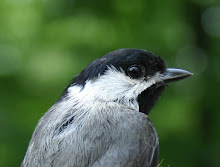I consulted with my entomologist friends on insect identification. As we all know, there are thousands of insect species and I am mostly unfamiliar with WHERE to look a bug up in the field guide. Speaking in bird terms, if I see a small bird with a thick bill, I think that bird is mostly likely a Vireo species, so I know to look in the Vireo section of my book. With bugs, well, I have NO clue, but thankfully, I know people who do know which section of the field guides to scan first.
Once my friends and colleagues responded with the species, I went a step further and did a little research on the internet. So without further ado...
I first came across this large moth on the edge of the woods.

It is most likely a Beloved Underwing (Catocola ilia). As with most moth species, the female Underwing emits an airborne pheromone and the males use their large, brushy antennas to pick up and follow the scent plume. The eggs are deposited on tree bark and hatch the following spring. The caterpillars eat the leaves of White Oak, Burr Oak, Northern Red Oak and Black Oak trees. Adult moths are found June - September.
On the edge of the north side of the prairie, I found a Bumblebee resting comfortably on the leaf of a Cup Plant. I love the way the wings shimmer in this photograph.

There is a small patch of prairie on the southeast corner of the property and I came across a section that was alive with buzzing wings. I spent a long time taking pictures.
I originally thought this to be a Thread Waisted Wasp, but I've been since told it is actually a Thick headed Fly (Conopidae sp). Now that I've seen photos of both, I can tell the difference.

As you can see, the Thick headed Fly mimics the appearance of a wasp and there are 70 species in the Conopidae family. The mimicry protects these insects from predators and they deposit their eggs into the abdomen of their hosts in flight. I found this insect among several bumble bees, honeybees and other flying insects and I learned this is common behavior. When the larva hatch they will eat their living food, from the inside out.
After reading all of that, I can't help but wonder how many of the bumble bees I photographed have little Conopidae eggs inside their abdomens, just waiting to hatch...

Let's end on a positive note, shall we? I found this little skipper, most likely a Fiery Skipper, resting on a Slender Mountain Mint plant.


Sigh. Now I will have nightmares about larvae eating their way out of my abdomen. And if it's not too much to ask, could you please refrain from using 'nest boxes' and 'itching' in the same sentence? Because now I will worry about The Pony gathering eggs from the nest boxes in the chicken coop. Sigh. I think I have creepy-crawly issues.
ReplyDeleteI wish you could have been in Hillmomba at 8:30 this morning, with your camera ready. A black hen chased a white or pale lavender moth across the front yard, jumping at it like a dog after a treat, and then caught it in mid-air and ATE IT. She acted like it was kind of dry going down.
LOL Hillbilly Momma. I should kidnap you and have you check nest boxes with me to help with your creepy crawly issue. They really aren't THAT buggy. ;)
ReplyDeleteI love hearing about your chicken getting a little extra protein. Should I tell you how I accidentally ate a mosquito Thursday? Well, I guess I just did so I'll tell you the details. I had one buzzing in my ear and when I opened my mouth to complain, another flew in. I inhaled at the shock and well...there it went.
Oh geez...you're never going to visit my blog again, are you?
Sighhhhh...I don't get no respect. Just keep the crickets out of it, and I'll come back. I despise crickets, much like Renee Zellweger as Ruby Thewes in Cold Mountain despised a floggin' rooster.
ReplyDelete